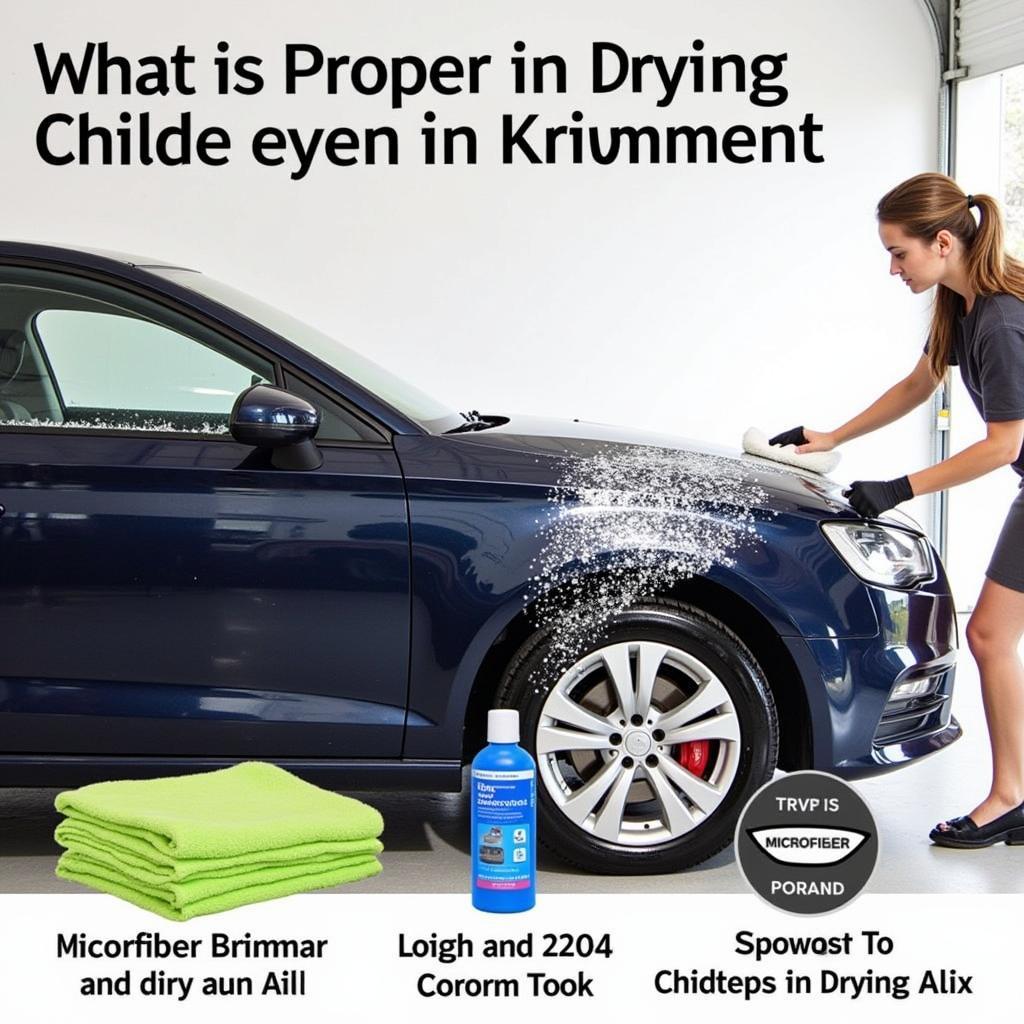Drying your car after detailing isn’t just about getting it shiny; it’s a crucial step to protect your paintwork from water spots and ensure a truly professional finish. Improper drying techniques can undo all the hard work you’ve put into cleaning and polishing, leaving behind unsightly marks and potentially even damaging the clear coat. This guide will walk you through the best practices for drying your car after a detail, ensuring a spotless, streak-free result every time.
The Importance of Proper Drying Techniques
Water, especially hard water, contains minerals that can etch into your car’s paint, creating those frustrating water spots. These spots aren’t just an aesthetic issue; they can actually damage the clear coat over time. By drying your car correctly, you’re preventing these mineral deposits from forming and preserving the pristine finish of your paintwork. Furthermore, proper drying minimizes the risk of swirl marks and scratches that can occur if you use a dirty or abrasive drying towel.
Essential Tools for Drying Your Car
Before you begin, gather the right tools. A high-quality microfiber drying towel is an absolute must. Microfiber is incredibly absorbent and gentle on your paint, minimizing the risk of scratches. A dedicated car wash shampoo formulated to sheet water off the surface can also significantly reduce drying time. Consider a water blade, often referred to as a “squeegee,” which can effectively remove a large amount of water quickly. Finally, a quick detailer spray can be used as a drying aid to further lubricate the surface and prevent streaks.
Step-by-Step Guide to Drying Your Car Like a Pro
- Pre-Rinse: After washing your car, give it a final rinse with clean, filtered water if possible. This helps to minimize mineral deposits.
- The Sheeting Method: If you used a sheeting car wash shampoo, much of the water will have already run off the surface, making your job much easier.
- Using a Water Blade: If you’re using a water blade, start at the top of the car and work your way down in overlapping strokes. Dry the blade after each pass to avoid spreading water back onto the surface.
- Drying with Microfiber Towels: Fold your microfiber towel into quarters. This provides multiple clean surfaces as you dry. Start from the top of the car and work your way down, using gentle, straight strokes. Do not rub in circles as this can create swirl marks. Flip or refold your towel frequently to ensure you’re always using a clean, dry section.
- Drying Aid: A quick detailer spray can help lubricate the surface and prevent streaks. Lightly mist a section of the car and then gently dry with a clean microfiber towel.
Common Mistakes to Avoid
- Using old or dirty towels: This is a recipe for scratches! Always use clean, high-quality microfiber towels.
- Rubbing in circles: This can create swirl marks that dull the finish of your paint.
- Letting the car air dry: This increases the risk of water spots, especially in direct sunlight.
- Using household cleaning products: These can strip the wax and damage your car’s paint.
Why Drying Matters Even in a Covered Area
Even if you’re drying your car in a garage or covered area, proper drying is still crucial. While the risk of water spots is reduced, water can still linger in crevices and seams, potentially leading to corrosion over time. Also, a thorough drying ensures that your wax or sealant can bond properly to the paint, providing optimal protection.
 Car Drying in Garage
Car Drying in Garage
Just as detailing a new white car requires specific techniques, so does drying any car after a detailed wash. By following these simple steps, you can achieve a showroom-worthy finish and protect your car’s paint for years to come. For more information on how to prevent microfiber from getting lint during your car detail, check out this guide: how to prevent microfiber from getting lint car detail. This article, like our guide on can detailers get scratches out of car, emphasizes the importance of using the right tools and techniques to protect your car’s finish.
Conclusion
Knowing how to dry up your car after detailing is a fundamental skill for any car enthusiast or professional detailer. It’s the final, crucial step that ensures your hard work pays off, leaving your car with a flawless, protected finish. By investing in the right tools and following the correct techniques, you can avoid water spots, swirl marks, and other imperfections, keeping your car looking its best. If you’re looking for more information on car detailing, check out how to detail a new white car. If you’re curious about steaming, you can also read more on how to sleam clean a car for detailing. And finally, make sure to avoid common detailing misconceptions by reading a guide to popular car detailing myths.
FAQ
- What is the best type of towel to dry a car? High-quality microfiber towels are the best choice.
- Can I let my car air dry after washing? No, this can lead to water spots.
- What should I do if I get water spots on my car? A dedicated water spot remover can often help.
- Is a water blade necessary for drying? It’s helpful for quickly removing large amounts of water.
- How often should I wash and dry my car? This depends on your driving conditions and personal preference, but generally, every 1-2 weeks is a good guideline.
- What is a quick detailer? It’s a spray-on product used as a drying aid to help prevent streaks and add shine.
- Can I use a leaf blower to dry my car? While some professionals use this method with caution, it’s generally not recommended for beginners as it can blow debris onto the paint.
Need help? Contact us via WhatsApp: +1(641)206-8880, or Email: [email protected]. We have a 24/7 customer service team ready to assist you.

Leave a Reply